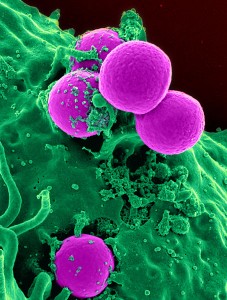We are in a constant war and we don’t even realize it. No, it’s not the recent development in Ukraine or the crisis in Syria some time ago. It’s something much more subtle and dangerous. As you may have guessed it from the title, we are constantly fighting against bacteria with a type of weapon called antibiotics. Antibiotics are natural products used to kill bacteria by interfering with bacteria growth or replication. Unfortunately, we have been using our weapon inappropriately and now we are steadily losing this fight against bacteria.

Face of Danger (antibiotic-resistant bacteria, MRSA, at work. Image source: wikimedia)
However, researchers from the division of Healthcare Quality Promotion at the U.S. Centers for Disease Control and Prevention (CDC) found something we can do to fight against bacteria. According to the study done in 2013 by Fridkin, S.K. and Srinivasan, A. (associate director for Healthcare Associated Infection Prevention Programs), by fusing antimicrobial stewardship with their strategies, hospitals in the U.S. is able to create a sort of benchmark for all hospitals to follow (2014). This is necessary as there is no clear guideline about how much of antibiotics is “too much.” In order to do this, they went through a trial and error of implementing sound decisions and comparing outcomes within 200 hospitals in U.S..
Now, here is why you might be asking why this is necessary at all when antibiotics can kill bacteria and have been doing so for the longest time. That is only half right. While we have been killing bacteria with antibiotics, they have been evolving through exposure of antibiotics and have become immune to them. As they become immune to the only weapon we have against them, we are forced to create or modify the antibiotics. This is called, “evolutionary arms race.”

While manufacturing new antibiotics would be good and all, there has been reports of misuse of antibiotics in hospitals and other medical centers as early as late 1950’s which resulted in rise of antibiotic-resistant bacteria (Fridkin, S.K. & Srinivasan, A., 2014). If this faulty practice continues, all the effort and money went into producing antibiotics would be in vain as they would develop immunity again due to overexposure. Therefore, a new practice of controlling distribution of antibiotics called, “antimicrobial stewardship,” has been developed.
Just like how it is not wise to show all your cards in your hand during a poker game, it is not wise to show every antibiotics we got by misusing them. While this study proves that we can set a guideline for all hospitals to follow, it also supports further improvements over their strategies. To prevent a certain future where no cure exists to fight against lethal bacteria, I believe there should be more improvements on the guidelines and if possible, we as citizens should also be smart about our usage of antibiotics.
References
Fridkin, S. K., & Srinivasan, A. (2014). Implementing a strategy for monitoring inpatient antimicrobial use among hospitals in the united states. Clinical Infectious Diseases, 58(3), 401-406.
– Jong Hwan Seo



